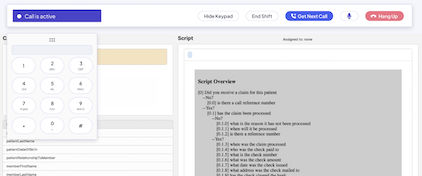
SuperDial
Founding product designer for an AI outbound health care phone caller
Out of the ashes of SuperPay rose SuperDial, the next big pivot for SuperBill. While filing out-of-network claims for patients in SuperPay, we needed to call a patient’s insurance company to verify their benefits. This took over 30 minutes per call (working through the insurance company’s automated IVR system, waiting on hold, etc.), and we desperately needed to streamline this process to remain profitable.
With recent developments in AI, we made our own “robodialer” that would call insurance companies on our behalf. This worked quite marvelously for us, and we quickly realized that practices, billers and RCM companies alike all needed the same thing, just different “scripts”. Thus began the SuperDial journey.
With recent developments in AI, we made our own “robodialer” that would call insurance companies on our behalf. This worked quite marvelously for us, and we quickly realized that practices, billers and RCM companies alike all needed the same thing, just different “scripts”. Thus began the SuperDial journey.
My role
I was the sole designer at this 8-person company and designed every feature in the web apps and marketing site. I also did a good deal of full-stack development, from implementing self-serve API configurations to handling front-end UI work. I lightly PM-ed the portal features by developing product roadmaps, and performed the bulk of QA testing before we deployed to customers. Typical startup role!
Platform Overview
Customer Portal: Customers can define scripts, place calls, view results, and perform sandbox developer tasks.
Internal Audit Platform: An internal tool for us to review AI call performance.
Internal Call Center: An internal tool to manually place calls ourselves if the AI failed.
Internal Audit Platform: An internal tool for us to review AI call performance.
Internal Call Center: An internal tool to manually place calls ourselves if the AI failed.
Design Case Studies
The process behind SuperDial's "Script Builder" that facilitates the AI conversation
Read more
Elegantly accomodating 2 different personas in one platform
Coming Soon
 Call Center, Reimagined
Call Center, Reimagined
Building a custom internal tool without reinventing the wheel
Coming Soon
Development Work Overview
I won’t deep-dive into my development work, but here are examples of features I built:
 Translating design to production
Translating design to production
 2-Factor Authentication
2-Factor Authentication
 PDF generation
PDF generation
 Self-serve API configuration
Self-serve API configuration
My first step into development was owning the front-end work, which involved writing javascript, employing Tailwind CSS framework for the UI, and building reusable React components
 2-Factor Authentication
2-Factor Authentication
I built 2FA which involved Firebase Auth + Identity Platform management, tracking tokens, and signing users out after 1 hour or 30 days depending on preferences
 PDF generation
PDF generation
We return call results in a CSV format, but I helped convert the CSV to PDFs using Beautiful Soup (Python HTML parser), and I implemented the ability to customize PDFs with customer logos
 Self-serve API configuration
Self-serve API configuration
I built an API configuration page to allow customers to generate their own sandbox and prod API keys + secrets, which involved front-end React components and back-end python code to generate keys/secrets to store in the database
Next Project
SuperPay